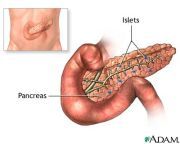Article
Transplantation of Human Islet Cells Safe and Effective in Type 1 Diabetes
Author(s):
Phase III trial shows that transplanted purified human pancreatic islets safely restored sustained near-normoglycemia and provided protection from severe hypoglycemia in patients with long-standing type 1 diabetes and iatrogenic hypoglycemia.

During the final talk of the President’s Oral Session at the American Diabetes Association’s 74th Scientific Sessions Bernhard Hering, MD, Professor of Surgery, Eunice L. Dwan Diabetes Research Chair, Scientific Director of the Schulze Diabetes Institute, and Director of the Islet Cell Transplantation Program at the University of Minnesota, presented information on behalf of the Clinical Islet Transplantation Consortium regarding an ongoing phase 3 trial of the transplantation of human islets into type 1 diabetes patients.
“Interventions for prevention of severe hypoglycemia in type 1 diabetes include meticulous prevention, structured education, real-time continuous glucose monitoring, and sensor-augmented insulin pump therapy. However, not all patients benefit from such medical interventions.Many patients with type 1 diabetes have impaired awareness of hypoglycemia and severe hypoglycemic events resulting in significant morbidity and mortality,” said Hering.
The Clinical Islet Transplantation Consortium conducted a prospective, open-label, single-arm phase 3 multi-center studyto determine the effectiveness and safety of transplanting an allogeneic purified human pancreatic islet product in the treatment of patients with type 1 diabetes.
For the study, a total of 8 centers enrolled 48 adult participants (age 18-65 years). The study population all had type 1 diabetes for ≥5 years, <0.3 ng/ml stimulated C-peptide, one or more episode of severe hypoglycemia in previous year, and documented reduced awareness of hypoglycemia and/or marked glycemic lability.
Subjects received intraportal transplants of purified human pancreatic islets (PHPI). Induction immunotherapy included antithymocyte globulin and etanercept; maintenance immunosuppression comprised sirolimus and tacrolimus. Treatment included up to 3 intraportal infusions of PHPI within 8 months.
All 48 subjects reached 1 year of post-initial transplant follow-up for primary endpoint evaluation. Out of 48 participants, 26 received a second transplant, and 1 subject received 3 transplants.
The primary endpoint was the proportion of subjects with HbA1c <7.0% at Day 365 and free of severe hypoglycemic events from Day 28 to Day 365 inclusive following the first islet transplant. There were multiple secondary endpoints for safety and efficacy.
At 1 year after the first islet infusion, more than half of subjects were insulin-independent. Insulin use dropped from a median at baseline of 0.49 U/kg/day to a median of 0.00 U/kg/day (range 0.00 to 0.43) at Day 365. C-peptide levels increased and glucose levels decreased in response to a mixed meal tolerance test (p <.0016). At Day 365, 94% of patients had a functioning graft with basal or stimulated serum C-peptide levels >0.3 ng/ml.
There were no study-related deaths or permanent morbidities. Kidney function was minimally affected by the introduction of immunosuppression. The 48 participants experienced 19 study-related serious adverse events (SAEs). These included procedure-related bleeding following percutaneous cannulation of portal vein (n=5), immunosuppression-related SAEs such as transient neutropenia, cytokine release, and elevated liver function tests (n=13), and hypoglycemia in a subject on insulin (n=1). None of these SAEs resulted in death or disability and none required expedited reporting to the FDA.
In terms of adverse events (AEs), 6 subjects had non-zero calculated panel-reactive antibodies of 2%, 7%, 17%, 23%, 25%, and 74%, respectively; only the last of these had a donor-specific antibody. One subject had acute kidney injury of unclear etiology.
In conclusion, Hering told the audience, “Real-world frequency of severe hypoglycemia is much higher than suggested by clinical trial data and remains alarmingly high.Transplanted purified human pancreatic islets safely restored sustained near-normoglycemia and provided protection from severe hypoglycemia in patients with long-standing type 1 diabetes and iatrogenic hypoglycemia. Islet products meeting all release criteria can be prepared at multiple manufacturing centers using a standardized protocol. Based on these results, islet transplantation should be considered in this subgroup of patients when other treatment options have failed.”




